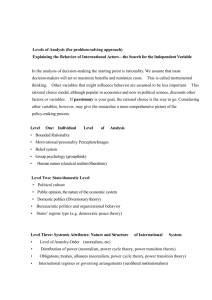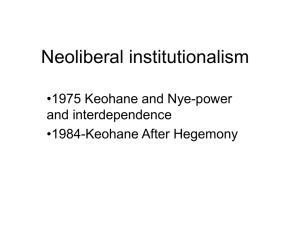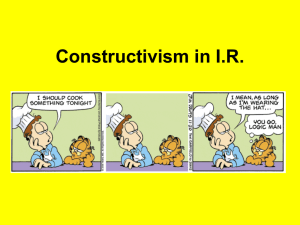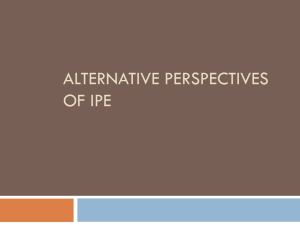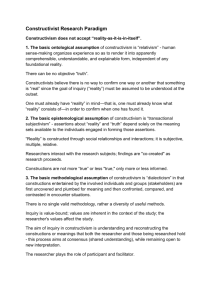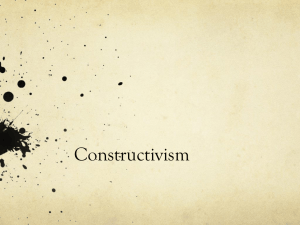Theories of International Relations
advertisement
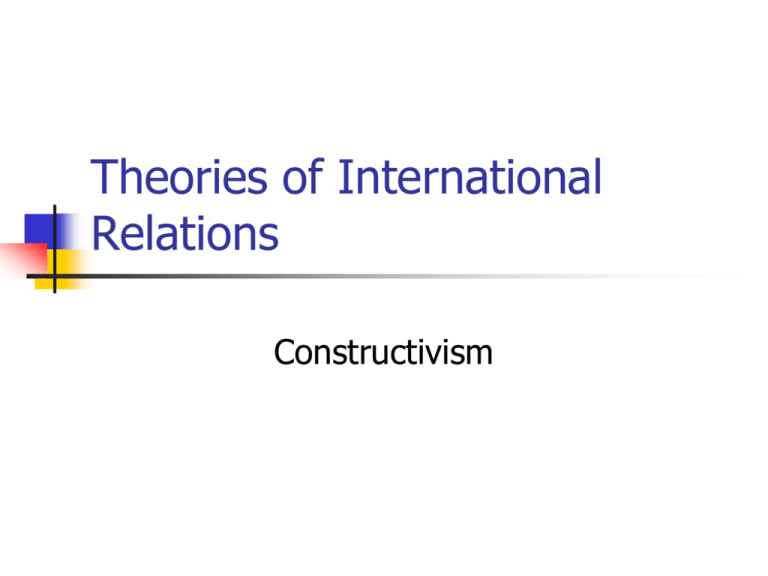
Theories of International Relations Constructivism Introduction Neorealism and Neoliberal Institutionalism dominated the 1980s and much of the 1990s too. Both understand states as having interests or a purpose, given by structure of anarchy. Neoliberals thought states can mitigate anarchy by creating institutions that would discourage cheating and encourage cooperation for mutual gain. Neorealists are doubtful about this. Constructivism breaks with the ideas of mainstream theories and argues that international relations is a product of human action. Challenging State-Centrism Both neo-realism and neo-liberal institutionalism assume that states have fixed interests. Material forces such as distribution of power constrain states to pursue those interests. Constructivist scholars instead emphasized ideational forces such as ideas, knowledge, norms, and rules to understand the origins of state’s interests Constructivism is based on the belief that societies shape the identities and interests of individuals. Thus, it conceptualizes international politics not as a system but as a society Challenging State-Centrism Neorealism does not accept that ideas and norms define interests.Neoliberalism argues that states might willingly construct norms and institutions to enhance their long-term interests. Neither neorealism nor neoliberalism accept that ideas and norms construct how states define their interests. Neorealism and Neoliberalism share idea that the actors (states) are given. Their interests exist prior to interaction with each other. Relations do not shape interests. The world is understood as a strategic space, not as society. So states are rational, not socialized into norms or ways of behaviour. Any cooperation for mutual gain does not change the identity or interests of states. Challenging State-Centrism Constructivists interested in the origins of state interests or preferences, and the idea that these change over time. Variation in the identity of states is crucial to them. Hence, anarchy is not the automatic mechanism as Neorealists and Neoliberals argue. For Constructivists, the sovereign state and anarchy are something humans have made. John Ruggie challenges Kenneth Waltz Ruggie focused on the centrality of ideas and norms in international politics. In his review essay (1983) of Waltz’s ‘Theory of International Politics’, Ruggie challenged Walt’z argument that the structure of the international system is anarchy. He criticized that Waltz focused on selfhelp logic, distribution power and did not differentiate between states. Ruggie instead focused on differentiation. Richard Ashley challenges neorealism He argued that neorealism is so focused on the state that it cannot see a world composed of non-state actors. It treats states as having fixed interests and thus cannot see how their interests are created. It is committed to materialism that it constructs an artificial view of society that is completely devoid of ideas, beliefs, and rules. It fails to see that basic concepts of international relations such as sovereignty is socially and culturally produced. Alexander Wendt introduces ‘Structure and Agency’ problem For Neoliberals and Neorealists, states pursue their interests within the constraints of an anarchic system. Wendt questions this view of the relationship between structure (the system) and agency (states). For him, structures do not just constrain pre-given agents. They also help to give agents identities and interests, to ‘make’ them. Agents not just subject to structures. Agents can make and transform structures too. The normative structures can create agents and the agents can create and transform the structure. Friedrich Kratochwil He offered one of the first systemic treatments of rules and norms in IR. He distinguished between regulative rules and constitutive rules. Regulative rules are those rules that regulate already existing activities. Rules for the road determine how to drive or WTO’s rules regulate trade. Constitutive rules do not merely regulate but in fact create the possibility for new activities. For instance, the rules of sovereignty not only regulate state practices but also make possible the very idea of a sovereign state. The important point is how actors interpret and give meaning to these rules. The Rise of Constructivism: Nicholas Onuf Constructivism is a term coined by Nicholas Onuf in his book ‘The World of Our Making’ (1989). Onuf criticized mainstream theories for not predicitng the end of cold war. He argued that due to their commitment to individualism and materialism, they failed to see the revolutionary ideas to transform the organizations of world politics and state identities. For Onuf, the mainstream theories also would not predict how the future international system would look like after the end of cold war. For him, the distribution power would not predict whether the US would be a global hegemon or would prefer multilateralism and cooperation with other states. End of the Cold war: who are we? Constructivists argue that states began to debate their national identity (who are we, where do we belong?) in order to determine their interests and the desired international order. The end of the cold war undermined the prominence of traditional security themes and thus neorealism’s dominant position in the literature. The rise of non-security issues such as human rights contributed to the development of constructivism. IR as a social construction States, alliances or international institutions are examples of social phenomenon in IR. Social phenomena do not exist independent of human meaning and action Focus on change: Idea of social construction suggests difference across context not a single objective reality (e.g. end of Cold War questioned regularities in world politics; transition from conflict to cooperation) Central themes Social dimensions: Emphasis on norms, rules and language and how material and ideational factors combine in the construction of different possibilities and outcomes. The focus is on the diffusion and internationalization of norms (e.g. spread of liberal democracy) Processes of interaction: Actors make choices in the process of interacting with others bringing historically, culturally and politically distinct ‘realities’ into being (‘world of our making’) Constructivism is a diverse theory Although constructivism is a diverse theory, they are unified on the argument that ideas define international structure that constructs the identities, interests, and foreign policy practices of states. They also agree that non-state actors reproduce that structure and transform it. Constructivism is about human consciousness and its role in international life. Concrete facts and Social facts Concrete facts such as flowers, oceans, exist independent of human agreement or deny their existence. Social facts on the other hand are dependent on human agreement. Money, terrorism, human rights, and sovereignty are social facts. Social facts are ideas, norms, rules that we hold collectively to be true. Social Facts Although social facts are dependent on human agreement, we treat them as objective facts and thus as constraints on our action. States are social facts for Constructivists. They are ideas or mental structures. Material facts matter, but human design and intent shapes material objects and give specific meaning and use within a context. The social construction of reality influences how we see the world and also how we see what constitutes acceptable action. Alternative explanation for power The fact that concepts such as sovereignty or human rights are fixed through politics and that once these meanings are fixed they have consequences for the ability to determine the actions of people suggests an alternative explanation for power. Most IR theorists treat power as the ability of one state to compel another state to do what it otherwise would not. They assume that means of power such as military technology and economic power force states to alter their behavior. Constructivists argue that power is not just material, but also ideational. Alternative explanation for power When human rights activists ‘name and shame’, they embrass law-breaking governments and try to change their behavior by showing how their behavior is not consistent with existing legal norms. Moreover, the effects of power go beyond the ability to change the behavior. Power also includes how knowledge, fixing of meanings, and the construction of identities allocate different rewards and capacities: If development is defined as per capita income then states and some activities namely industrialization are priviliged; however if development is defined as basic needs, then other actors namely peasants or women become important.
